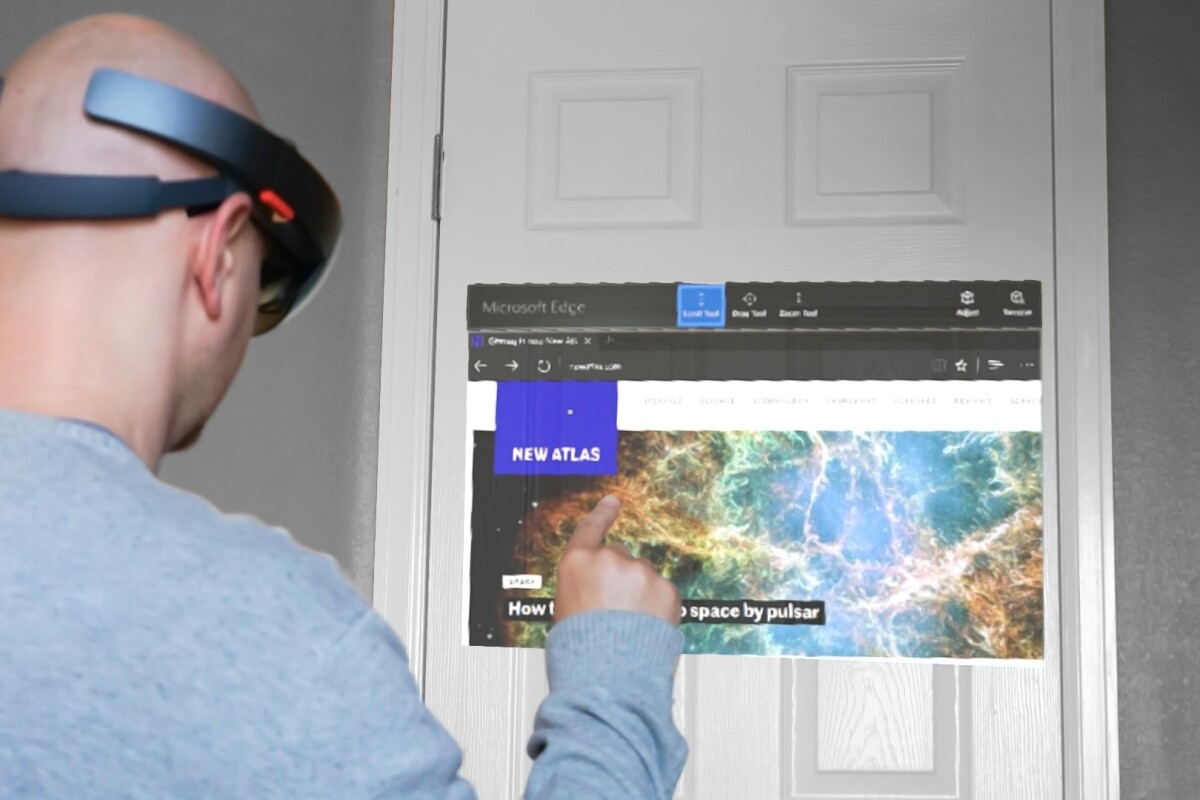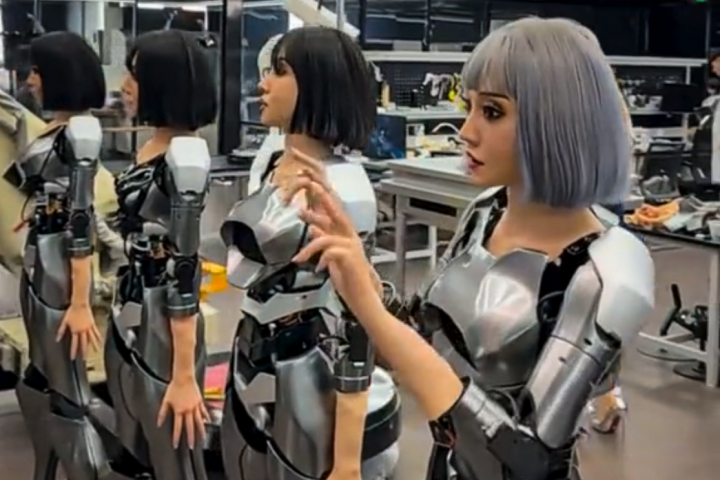Reviewing the Microsoft HoloLens dev kit is a bit like taking a trip to the future, returning home and then trying to describe it to your friends. Today's version isn't quite ready for prime time, and it may even be decades before AR headsets reach their full potential. But holy smokes, has Microsoft taken an impressive first step.
Before we jump in, keep in mind that "review" means something a little different when we're talking about pre-consumer developer hardware. Usually we publish these things to help you decide whether or not to buy products, but in this case that answer is simple: Unless you're a developer or filthy-rich early adopter, don't buy HoloLens right now. Its app selection is still small, and the consumer version will almost certainly cost less and improve on other things.
This is more about looking at where the tech is today, what it tells us about the future (near-term and long-term) and what needs to change to get us there.
With that in mind, what the developer version of HoloLens does is lay the groundwork for a type of product that's unlike anything we've seen before. While we already have virtual reality and we've seen other products described as augmented reality (AR), this is what we'd call the first "real" AR headset. Not only does HoloLens overlay virtual objects on top of your real-world view, but it also knows where your floor, walls, lamps and tables are – letting virtual and real intermingle as if they were all bound by the same physical limits.
So we have things like video game characters who run up the side of your wall, leap back off and then hop over onto your sleeping dog's back. You see app screens, whether Skype, Candy Crush or a web browser, pinned to your wall or TV set. Or human-sized virtual characters who take a seat in the chair next to you, while briefing you on your next mission.
There are other companies now working on similar things behind closed doors (including startup Magic Leap), but Microsoft firmly planted its flag in this AR turf when it revealed HoloLens 19 months ago, and no other public product is doing anything remotely close to this.

The ultimate AR headset of the future, the one ripped out of a million sci-fi fantasies, will do what HoloLens does today, while also adding things like a 180-degree field of view (FOV), all-day battery life and a form factor that doesn't make you look like RoboCop. What we have today is a decidedly at-home piece of gear, with only a few hours of uptime and a disappointingly small field of view.
To put the field of view into perspective, here's a shot we spliced together that illustrates roughly what Microsoft's promotional materials would have us believe looking through HoloLens is like today:

But here's roughly what you'd really see, looking at the same scene from the same angle:

Once you move your head and walk around to see the "holograms" from different angles, then your mind will start to put together the pieces and feel like there are virtual objects all around you. But at any given point, you're only going to see the virtual through a tiny little window floating directly in front of you. It's a big compromise.
The kicker is, when you take a step back and look at how polished the device is on the whole, and consider how extremely early it is in this AR game, HoloLens' FOV is completely acceptable. If the alternative were Microsoft keeping the device locked behind closed doors, waiting to reveal it to the public until the FOV was closer to virtual reality's 96-110 degree range, then we can live with the tiny view. We love these kinds of previews that pre-release gear like HoloLens allows us to have.
We just can't help but dock points when a company unnecessarily sets such unrealistic expectations. We appear to be a ways off from AR that fully blankets your entire eyesight.

If you can get past the FOV, HoloLens can take you on magical journeys. Unlike VR, where you forget about your real surroundings while you're seemingly teleported to fantasy lands, AR instead mystifies you by merging the fantasy with the real. So you can have a video call with someone who scribbles instructions that float in mid-air, kick back and watch YouTube videos in what looks like a 50-inch TV hanging on your wall or find a kidnapped child (fictionally, of course) by investigating a reconstructed crime scene in your own living room.
While what HoloLens can do right now is incredibly exciting, our imaginations really start firing when we look ahead at where this can eventually go.
The first consumer AR will likely be just a half-step or two ahead of what we see today. But even a primarily at-home device like this with a very limited field of view could still be a killer first-gen product. The key is giving developers time to create more, deeper and more imaginative apps that build on the small sample we see today.
Much further down the road, once the FOV conundrum is solved, when form factors are subtle enough to be socially acceptable and battery life can last a full day, then the sky will be the limit. At that point, you might be able to throw away your smartphone. When you can hang (or float) a screen anywhere you want, create virtual versions of the real devices you use today, and have a holographic video call with someone on the other side of the world, you might find that the touchscreen computer sitting in your pocket is no more essential than a landline telephone is today.
If you always imagined a sci-fi future ripped out of Minority Report (or any of hundreds of other sci-fi/fantasy material), with floating screens and holograms all around you, controlled with your bare hands, then that's more likely to happen via the illusion of AR than any other way.

Back to the physical headset itself, it's much more polished than you'd expect from pre-release developer gear. I found it to be light and comfortable, and not bad to wear even with glasses on underneath. Its built-in speakers use positional audio, so sounds appear to be coming from the same direction that they look like they're coming from. And while we haven't dared damage-test the US$3,000 review unit, it at least feels sturdy, with plastic that's more of the thick and solid variety than the less desirable thin and flimsy extreme.
Battery life is only a few hours right now, which is plenty for us. Unless you're passing HoloLens around for different friends or family members to spend an hour or more with, we don't think you'll need to leave it on any longer than that right now. Battery life won't need to be off-the-charts until companies start making versions that look something like regular glasses, which you'll want to wear out in public. Today's HoloLens most definitely isn't there.

In-air gesture control works fine for the current model's limited usage. We aren't at the point yet, though, where you can reach, swipe and tap your hands completely intuitively, and see the "holograms" respond as smoothly as if you were swiping your smartphone: It requires very specific gestures that the headset walks you through the first time you put on the headset. In this way the human is still asked to adapt to the tech, rather than the other way around, which is usually a huge red flag that something isn't yet ready for mass-consumer consumption (it isn't).
Microsoft does include a little Bluetooth-enabled clicker control device, which we find preferable to the somewhat cumbersome hand gestures.

Looking at HoloLens for what it is, we see a small – but incredible – glimpse into the future.
Based on public comments that Microsoft execs have made, it sounds like dramatically improving the field of view may require more of a long-term rethinking than a series of short-term iterations. That's a little concerning. And, again, the blast-shield helmet design also dictates that we're many years, probably decades, away from the kind of subtle AR gear that anyone but the boldest early adopters will want to wear out in public. We believe the smartphone will be replaced by AR someday, but that day may be so far away that it's the iPhone 27 or Galaxy Note 38 that you're throwing out in favor of those magic glasses.
There will be a long transitional period in between what we see today and that ultimate AR future. The next step will be high-quality AR that's primarily something you use for either gaming or niche work (like 3D design, DIY instructionals, medical work or building plans) behind closed doors – and that will still be a very cool product. Before it broadens its horizons and replaces the smartphone, AR will sit next to VR as its homebody sibling.
As we said at the top, today's HoloLens isn't something you want to buy unless you're making apps for it. But if Microsoft can get the first consumer version's price down into a similar range as the best 1st-gen VR headsets + PC combo (let's say around $1,500), then HoloLens can play a similar role as today's Oculus Rift and HTC Vive: the futuristic early adopter gear that you invite your friends over to try, smiling as you watch their mouths hang agape the first time they put it on. A little piece of Harry Potter-like magic entering our decidedly Muggle world.
You can read more about the $3,000 HoloLens dev kit at the product page below.
Project page: Microsoft
















